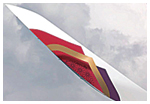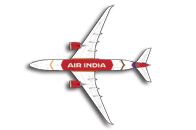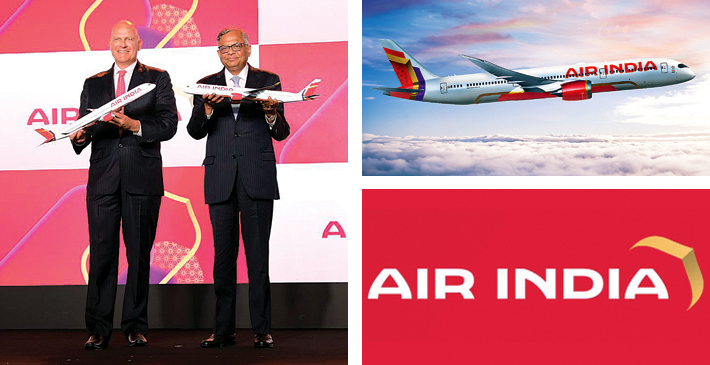Air India Unveils New Global Brand Identity and Aircraft Livery
From recruiting, and upskilling to completely rebuilding the internal systems, everything is being done to directly or indirectly make the experience better for customers

Earlier this month, Air India, a Tata Groupowned airline, revealed its “bold new look”. Air India called it “a modern new brand identity and new aircraft livery that capture the essence of a bold new India, marking a milestone in its Vihaan.AI transformation of the national institution into a national inspiration.”
The new look reimagines the iconic Indian window shape, historically used by Air India, into a gold window frame that becomes central to the new brand design system - symbolising a ‘Window of Possibilities’. Air India’s new logo symbol - ‘The Vista’ - is inspired by the peak of the gold window frame, signifying limitless possibilities, progressiveness, and the airline’s bold, confident outlook for the future. The new logo replaces the previous “Wheel of Konark”. Air India’s brand-new aircraft livery and design features a palette of deep red, aubergine, and gold highlights, as well as a chakra-inspired pattern. It also boasts a striking new custom-made ‘Air India Sans’ font, marrying confidence with warmth to position Air India as premium, inclusive, and accessible.
“Our new livery and design features a palette of deep red, aubergine, gold highlights and a chakra-inspired pattern. Travellers will begin to see the new logo and design starting December 2023,” tweeted Air India whiles sharing pictures of some CGI rendered aircraft.
AIR INDIA LIVERY OVERVIEW

AIR INDIA WORDMARK
Our bold wordmark reflects the renewed confidence and stature that Air India brings to the world. It is a hand-crafted asset which reflects world-class standards, while retaining an Indian flavour inspired by the shape of our hero signature window frame shape. The position is large in scale over the front half of the fuselage, purposeful and confident to be clearly legible at distance.
WINDOW FRAME WINGTIPS

On the inside of the wingtips, the tailfin design is replicated on a smaller scale for added personality and storytelling for passengers to enjoy. On the outside of the wingtip, a simple solid gold is used to convey premium cues and link to the hero gold frame.
HERO WINDOW FRAME TIP TAILFIN
The tailfin uses the tip of the window frame as a bold directional statement of progress. It is applied in premium metallic gold, and has shadows to give it depth and lift. The hero gold frame shape is supported by two dynamic supporting window frame shapes in Air India red and purple. The Jaali pattern detail is inspired by the chakra from the original logo.
GOLD FRAME UNDERBELLY
The hero gold frame is applied as surrounding highlight element to the solid Air India underbelly red frame shape (which holds the Air India wordmark). This gold frame detail adds storytelling and premium cues, while bringing extra attention to the underbelly wordmark.
RED ENGINE HOUSINGS
The engine housings are painted in solid Air India red. The visual story of the hero gold window frame is also continued with a simple gold band which is applied around the front of the engine housing.
UNDERBELLY WORDMARK

The Air India wordmark is also applied at large scale to the under belly. It sits on an Air India red window shape applied to the underside of the fuselage to allow our aircraft to be recognised easily from below when flying at low altitude.
Source: Air India
Campbell Wilson, Air India CEO & MD, said: “Our transformative new brand reflects an ambition to make Air India a worldclass airline serving guests from around the globe, and that represents a new India proudly on the global stage. The new Air India is bold, confident, and vibrant, but also warm and deeply rooted to its rich history and traditions that make Indian hospitality a global benchmark for standards in service. There’s a long way to go but we have made a good start.”
Designed in partnership with the brand transformation company, FutureBrand, the iconic new brand identity combines Air India’s glorious past with its drive to aim for excellence and innovate for the future, creating a standout brand design for a premium global airline with an Indian heart.
Travellers will begin to see the new logo throughout their journey starting December 2023, when Air India’s first Airbus A350 enters the fleet in the new livery. “Colours, patterns, shapes and how they come together and what they represent matter, but our actions speak so much louder. We are in the midst of a total transformation to reimagine the role of India’s flagship airline”, Wilson said. In keeping with the brand refresh, the inaugural aircraft, a Boeing 737 MAX, will make its debut in October. Air India Express (IX), a lowcost subsidiary, is expected to debut its new livery in October. Airbus A320neo and Boeing 737 MAX, both options are being explored.
As part of the unveiling, the carrier has released three promotional videos – two of these provide more detail on the new livery and brand identity, while the third shows a CGI walk through of one of Air India’s refurbished four-class Boeing 777-300ER aircraft. The Tata Group-owned airline is set to embark on a $400 million programme to refurbish its entire widebody fleet, starting in 2024, including the installation of new seats in every cabin, new inflight entertainment systems, and inflight wifi connectivity. A third of the fleet will have been upgraded by March 2024, with the full programme due to be complete by the end of 2026.

From recruiting, and upskilling to completely rebuilding the internal systems, everything is being done to directly or indirectly make the experience better for customers, highlighted Wilson while also talking about the new in-flight Entertainment Systems in every seat. “In flight internet connectivity for the first time on an Indian airline at the cost of over 400 million US dollars. This is the largest refit ever undertaken by an Indian airline. Over the next 2.5 years, our entire long-haul fleet will be completely reborn,” he added.
Tata Sons chairman N. Chandrasekaran said, “We are fully committed to this journey to make Air India a world-class airline. Our aim and job is to make this our line a truly world-class and iconic airline that every Indian will be proud of. The vision we have for the airline is also in the backdrop of a new resurgent India.”
Wilson also added that the iconic mascot of the airline’ The Maharaja’ is an important part of the company. “Rumor of Maharaja’s death are greatly exaggerated, he will live on. We very much wanted to continue it with India’s diaspora. It is a total and complete transformation of Air India, and it is not just a changing of the brand.”
Air India is making significant investments throughout the guest experience to elevate its service, to regain people’s trust in its quality and to strengthen its position as the preferred airline for travelers flying to, from, and within India. Some of those conscious steps include:
- Air India has confirmed historic purchase agreements to acquire 470 aircraft from Airbus and Boeing at $70 billion (based on published list prices), with deliveries of the new aircraft starting in November this year.
- The transformation of Air India’s fleet has already begun with the airline leasing and buying 20 widebody aircraft this year. A $400 million programme to completely refurbish the interiors of its legacy fleet of 43 widebody aircraft commences mid-2024, which will lead to the installation of brand-new seats in every cabin, new inflight entertainment systems, and inflight Wi-Fi internet connectivity. By March 2024, 33 per cent of the airline’s widebody fleet will be upgraded, and over the next two-and-a-half years, its entire long-haul fleet will be reborn.
- Air India has launched a new website and mobile app, offering a significantly improved web experience with new digital tools and features.
- The carrier will also launch a new “open all hours, every day” customer contact centre in nine Indian and foreign languages by the end of this year, as well as a completely redesigned loyalty programme in early 2024 that will enable thousands of new redemption possibilities.
- The airline is investing in building completely new lounges at Delhi and New York JFK airports, having recently announced a global lounge network expansion, achieving 100 per cent lounge access coverage for premium customers at all destinations in its international route network.
- Air India has now welcomed more than 5,000 new staff, including 3,200 Cabin Crew and nearly 1,000 Cockpit Crew, who are helping to drive the cultural transformation taking place at the heart of Air India. It is also heavily investing in building one of the world’s largest aviation training academies in India that will upskill a massive number of aviation professionals.
BRAND TRANSFORMATION
- Air India has unveiled a modern new brand identity and new aircraft livery which captures the essence of a bold new India, marking amilestone in its Vihaan. AI transformation of the national institution into a national inspiration
- The new look reimagines the iconic Indian window shape, historically used by Air India, into a gold window frame that becomes central to the new brand design system - symbolising a ‘Window of Possibilities’
- Air India’s new logo symbol - ‘The Vista’ - is inspired by the peak of the gold window frame, signifying limitless possibilities, progressiveness, and the airline’s bold, confident outlook for the future
- The brand-new aircraft livery and design features a palette of deep red, aubergine, and gold highlights, as well as a chakrainspiredpattern. It also boasts a striking new custom-made ‘Air India Sans’ font, marrying confidence with warmth to position Air India as premium, inclusive, and accessible
- Designed in partnership with the brand transformation company, FutureBrand, the iconic new brand identity combines Air India’s glorious past with its drive to aim for excellence and innovate for the future, creating a standout brand design for a premium global airline with an Indian heart
- Consulting with multiple stakeholders, Air India and Future-Brand worked closely together in designing a brand that pays respect to Air India’s rich history and the nation’s vibrant culture, while also representing a New India that looks confidently to the future.
Founded by JRD Tata, Air India took its first flight on October 15, 1932. After 69 years as a government-owned enterprise, Air India and Air India Express were welcomed back into the Tata group in January 2022. Under the government’s divestment plan, the Tatas gained complete ownership of Air India and its subsidiary, Air India Express.
AIRASIA UPDATES
Following the divestment announcement, the AirAsia brand name can only be used for a period of 12 months. The deadline will therefore expire in October. AirAsia India needs to change the liveries and branding on all 27 of its aircraft.
AIX Connect, a division of Air India that operates as AirAsia India, disclosed that it has received regulatory authority to rename its operations as “Air India Express.” The regulatory approval was the result of the two airlines’ attempts to integrate. This breakthrough, according to the company’s press release, marks a critical milestone in accelerating integration efforts.
Air India Express, which currently uses 26 Boeing 737 and 28 Airbus aircraft from AirAsia India, is planning to add 23 more Boeing 737 MAX aircraft by the end of March. To bolster its international operations, Air India Express is also receiving about four A320neo aircraft from AirAsia India.
The well-liked ‘Gourmair’ in-flight meal menu from AirAsia India has been successfully incorporated by Air India Express to enhance the in-flight experience. Additionally, both airlines’ passengers now have access to the ‘Xpress Ahead’ priority services that were previously only available to AirAsia India passengers. These services provide expedited baggage handling, boarding, and check-in. Both airlines also intend to collaborate on a variety of other ancillary add-on services and shared sub-brands to improve passengers’ overall travel experiences.
On behalf of Air India Express, AirAsia India will launch its maiden international flight to Sharjah (SHJ) on August 28. This action comes after earlier in the month, when codeshare flights for Air India were launched by AirAsia India. Beginning on August 28, AirAsia India will deploy an Airbus A320neo on a daily rotation from Delhi (DEL) to Sharjah, Varanasi (VNS), Sharjah, and back to Delhi, according to schedule information provided by ch-aviation. The flights to Sharjah also represent AirAsia India’s first overseas endeavour.


The development comes before the anticipated union of the two low-cost carriers, which ch-aviation claims has received approval from India’s Directorate General of Civil Aviation (DGCA) and will likely be completed in the first half of 2024. The Air India group consisted of full-service Air India and two low-cost subsidiaries, Air India Express and AirAsia India, which are merging.
Taking significant steps, Air India is navigating through a major five-year transformation roadmap under the aegis of Vihaan.AI, with an ambition to become a world-class airline with an Indian heart. The first phase of this transformation, the taxi phase was recently concluded and focused on fixing the basics. These included bringing back to service many long grounded aircraft, the addition of talent across flying and ground functions, rapid upgradation of technology, and strengthening of customer care initiatives amongst others.





